Enjoy nature and history at Yamadera, a place related to Matsuo Basho

Yamadera is famous as a major tourist destination in Yamagata. The correct name is Hojuzan Risshakuji, and it is a spot with beautiful seasonal scenery and a history of being an important cultural property. In addition, there is a famous haiku by the haiku master Matsuo Basho, who visited this area and composed it, "The voice of a cicada, which seeps into the quietness of the rocks." This time, I climbed a mountain temple with such a history.
About Yamadera (Hojuzan Risshakuji)
・History/Origin
Built in 860 by Jikaku Daishi Ennin, the third head priest of the Tendai sect, this sacred mountain representing the Tohoku region is a sacred mountain of the Tendai sect.
・Profit
breaking up bad relation
·transportation
Yamagata Station → About 30 minutes by car / About 20 minutes by JR Senzan Line
Sendai City → About 1 hour 30 minutes by car / About 50 minutes by JR Senzan Line
Zao Onsen → about 60 minutes by car
・Time required for climbing Yamadera
Approximately 1.5 hours round-trip for the basic viewing course (all steps include stone steps)
・Mountain entrance fee
Adults: 300 yen Junior high school students: 200 yen Children (4 years old and over): 100 yen
・Opening time
8:00~17:00 *Final reception hours change depending on the season
・Sightseeing sites, etc.
Hojuzan Risshakuji official website: https://www.rissyakuji.jp/index.html
Yamadera Tourism Association Official Website: https://www.yamaderakankou.com/
*Please refer to each official website for the above information
About Matsuo Basho
One of the most famous haikai in Japan. Matsuo Basho composed a famous haiku when he visited Risshakuji Temple, "The quietness and the voice of the cicadas seeping into the rocks." This haiku is also left in the haikai travelogue "Oku no Hosomichi".
Precautions when climbing Yamadera
・Clothes
Basically, you can climb without mountaineering equipment. However, since you will be climbing a long stone staircase, it is recommended that you wear comfortable clothes that you don't mind sweating. As for shoes, choose comfortable footwear such as sneakers that won't hurt your feet.
·Belongings
Especially on hot summer days, it is easy to exhaust your physical strength, so please drink water frequently.
I went to Yamadera
Yamadera Station - trailhead
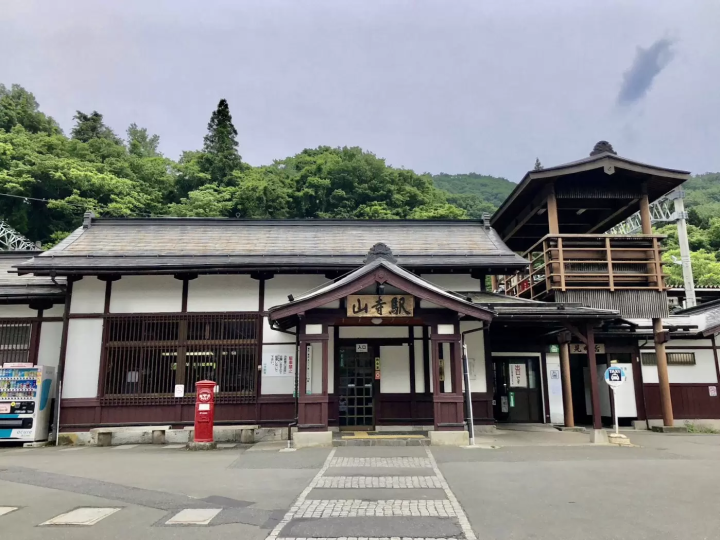
Start from Yamadera station. The appearance of the station matches the atmosphere of Yamadera. There is also a toilet on the right side. There are also coin lockers, so if you want to climb the mountain empty-handed, use them.
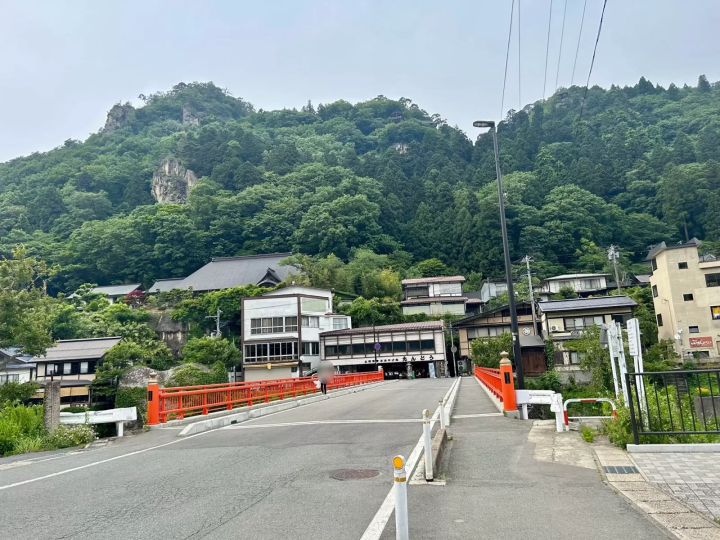
Exit Yamadera Station, turn right, and turn left at the first corner. You will see “Hoju Bridge” with its impressive red color.
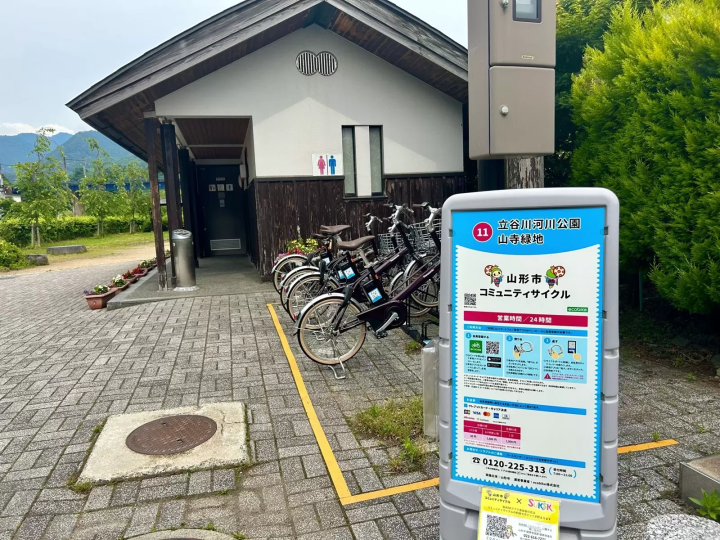
There are shared bicycles and washrooms near the bridge.
*Please see this article for information on sharing bicycles.
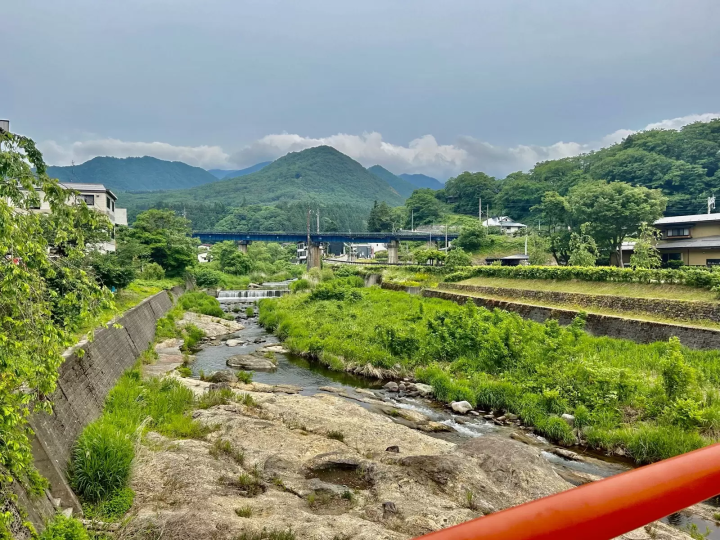
The view from Hoju Bridge is also very beautiful.
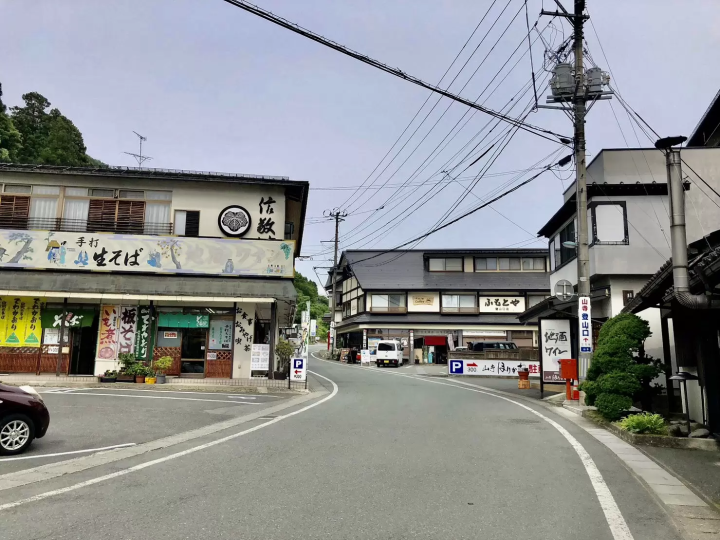
After crossing Hoju Bridge, turn right and follow the road.

You can see the trailhead of Hie Jinja Shrine on your left. You can also go to the mountain gate from here.
trailhead
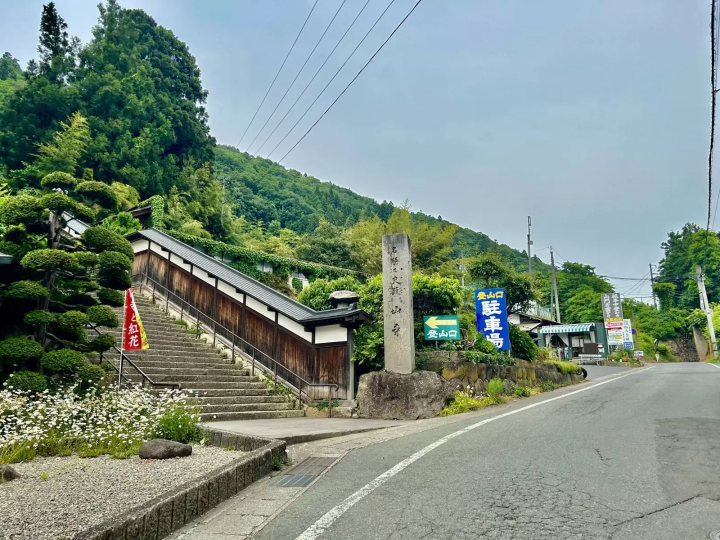
If you continue along the road, you will find the trailhead for Risshakuji Temple.
Konpon Chudo
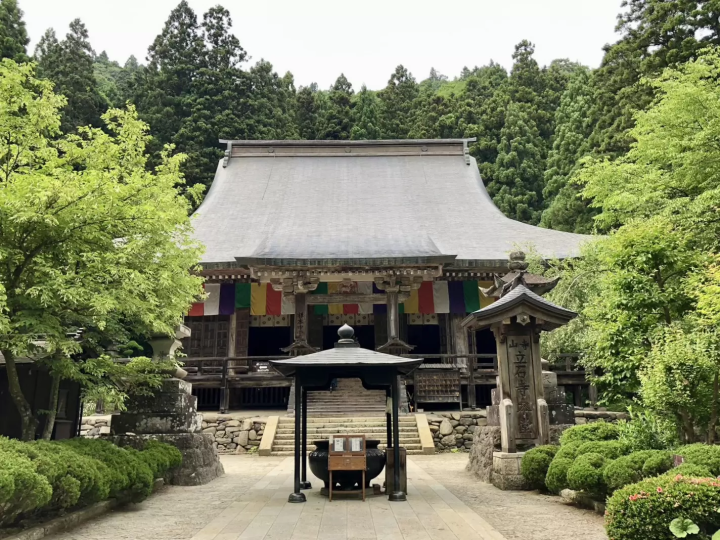
When you climb the stairs at the trailhead, you will find “Konpon Chudo” in front of you. It is a nationally designated important cultural property and is said to be the oldest beech building in Japan.
Basho Haiku Monument, Treasure Tower of Emperor Seiwa
As you follow the road, on your right hand side, you will find a stone tablet engraved with a poem written by Matsuo Basho when he visited Yamadera. There is a memorial tower for Emperor Seiwa in the back.
Hie Jinja Shrine
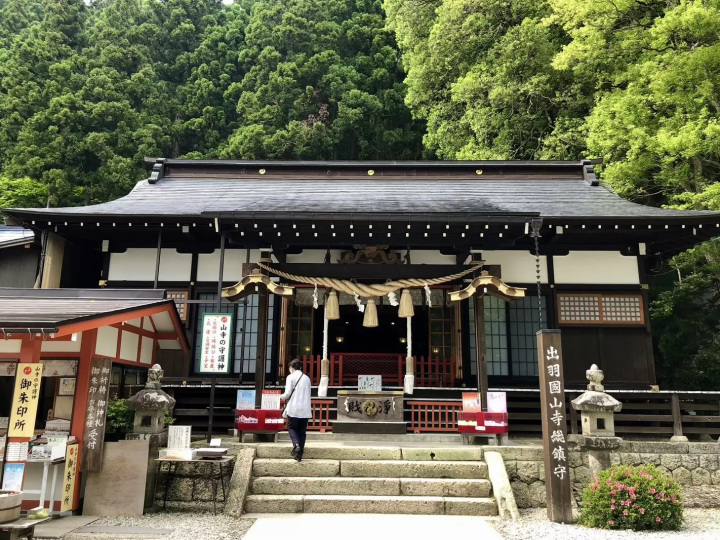
After passing the haiku monument, there is "Hie Jinja Shrine". The Yamadera Sanno Festival is held on May 17th, and the ginkgo tree in the background is said to be over 1,000 years old.
Official website: https://hie348.wixsite.com/yamaderahiejinja/yuisyo
Statue of Matsuo Basho
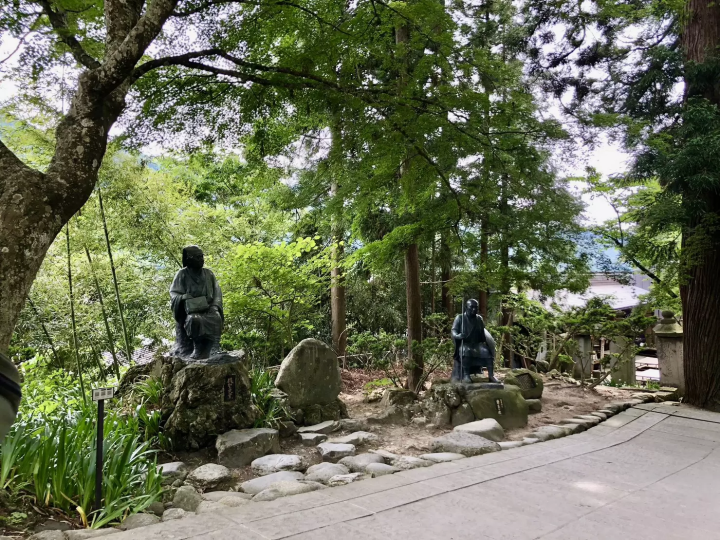
If you go along the road, you can see the stone statue of Matsuo Basho.
temple gate
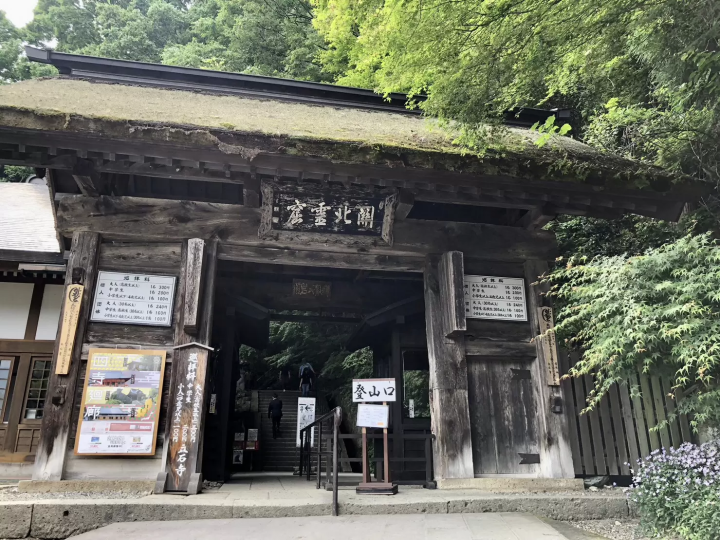
If you go straight along the road, you will see the mountain gate.
In front of the mountain gate, they sell the famous “Riki Konnyaku”, so it might be a good idea to eat it before climbing the mountain.
After passing the temple gate and paying the entrance fee at the temple office, we finally started climbing.
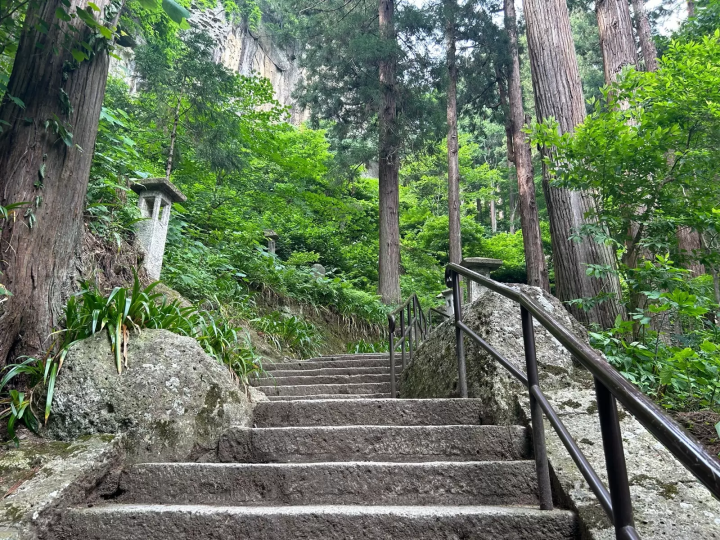
The stairs continue from here for a while. The air is very clear because it is surrounded by trees.
Ubado Hall
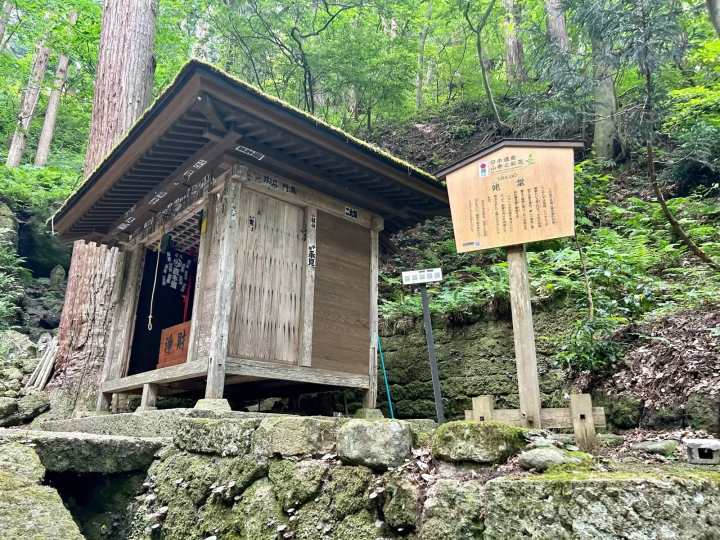
The first is Ubado Hall. The principal object of worship is a stone statue of Datsueba (an old woman's ogre who strips off the clothes of the deceased in the Sanzu River).
Semizuka (“Cicada Mound”)

This stone mound was filled with strips of paper that Matsuo Basho wrote when he visited Risshakuji Temple. It is called "Semizuka (“Cicada Mound”)".
Midahora
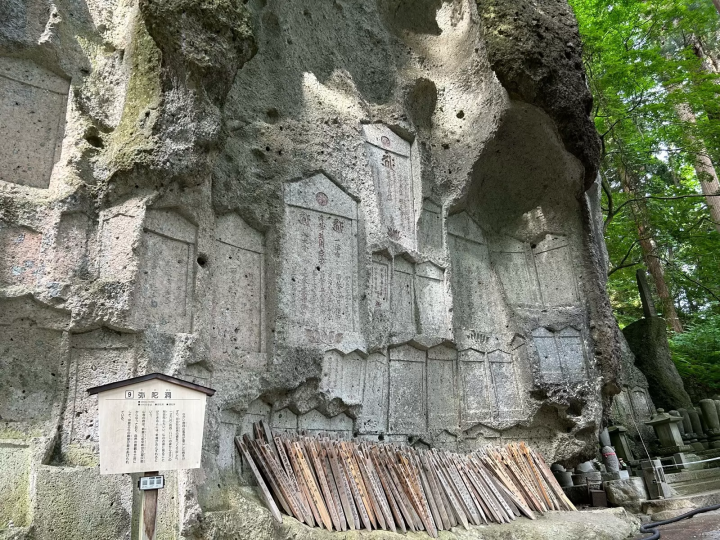
You will see a large cave on your right. This is "Midahora". It is said that rain and wind over a long period of time eroded the rock and created the figure of Amida Nyorai.
Niomon Gate

This big gate is called "Niomon Gate". Nioson statues are enshrined on the left and right, glaring at those who are evil-minded should not climb.
After passing through the Niomon Gate, there are temples such as “Kanmyōin”, “Shozoin Temple”, “Konjoin Temple”, and “Chushoin Temple”.
Okunoin
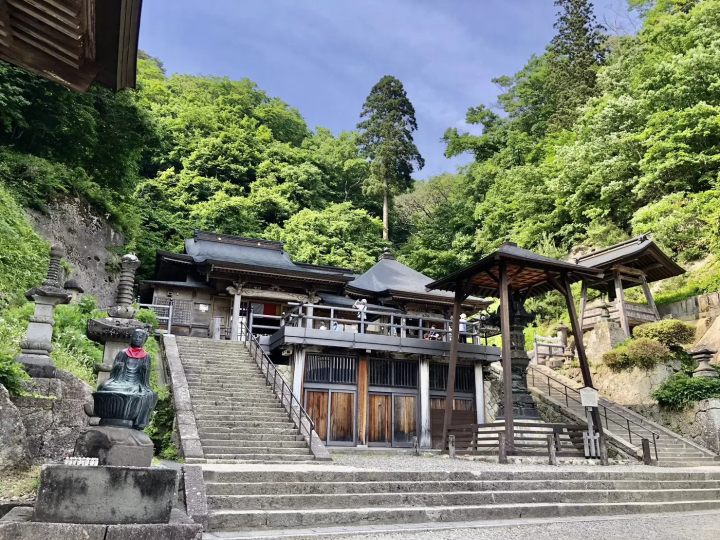
If you go up the stairs along the temple, you will find "Okunoin". The principal images of the temple are Shaka Nyorai and Taho Nyorai, which the founder Jikaku Daishi carried with him during his training in China.
If you turn left just before Okunoin, you will find “Mie Kodo”, a nationally designated important cultural property.
fork in the road

Also, on the way to Okunoin, there will be a fork in the road. If you keep going, you can head to the Nationally Designated Important Cultural Property "Nokyodo" and the "Godaido Hall" that juts out from the cliff. *You can go either before or after going to Okunoin.
Nokyodo and Kaisando
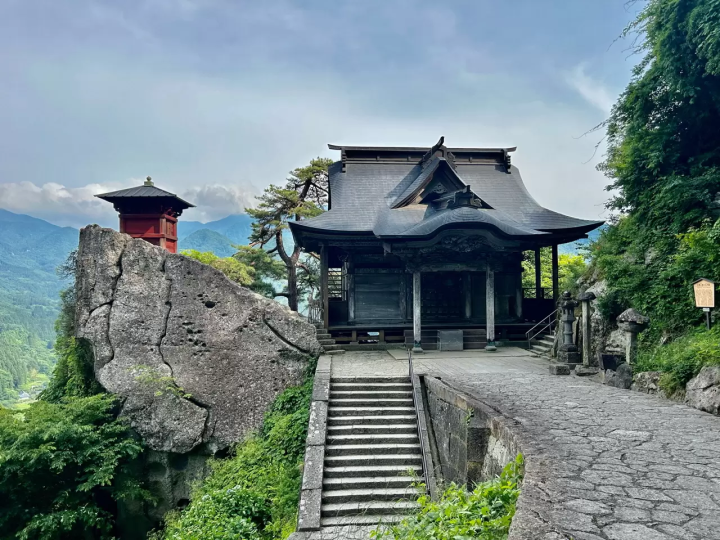
The red hall on the left of the image is the "Nokyodo."Kaisando is on the right. Nokyodo is a hall where sutras are stored and is the oldest building in Yamauchi. Kaisando is the hall of Jikaku Daishi who opened Risshakuji Temple.
If you go to the right at the Kaisando, you will find yourself on the road leading to Godaido Hall. The road is narrow and steep, so please be careful when walking.
Godaido Hall

After climbing the stairs, you will arrive at Godaido Hall.

Inside Godaido Hall. You can see the beautiful scenery of Yamadera. The wind is blowing and it is very comfortable. Godaido Hall is a dojo where the Godaido is enshrined and prays for world peace, and it is also the best observatory in Yamadera.
descent
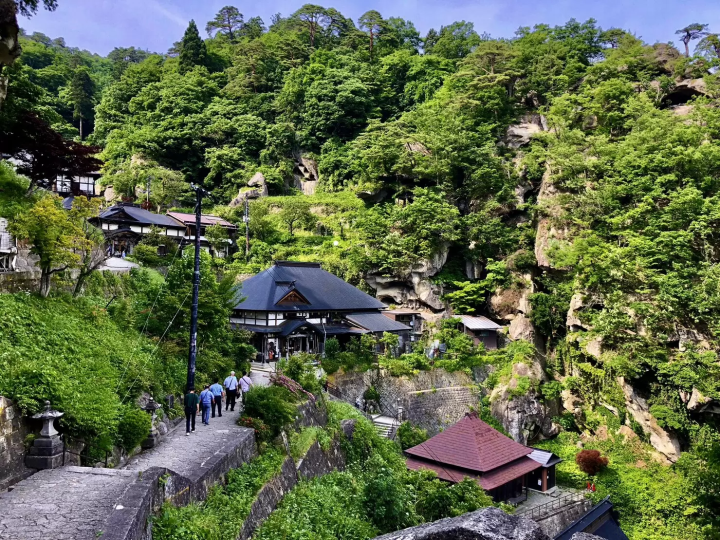
After enjoying the history and nature of Yamadera, slowly descend the mountain.
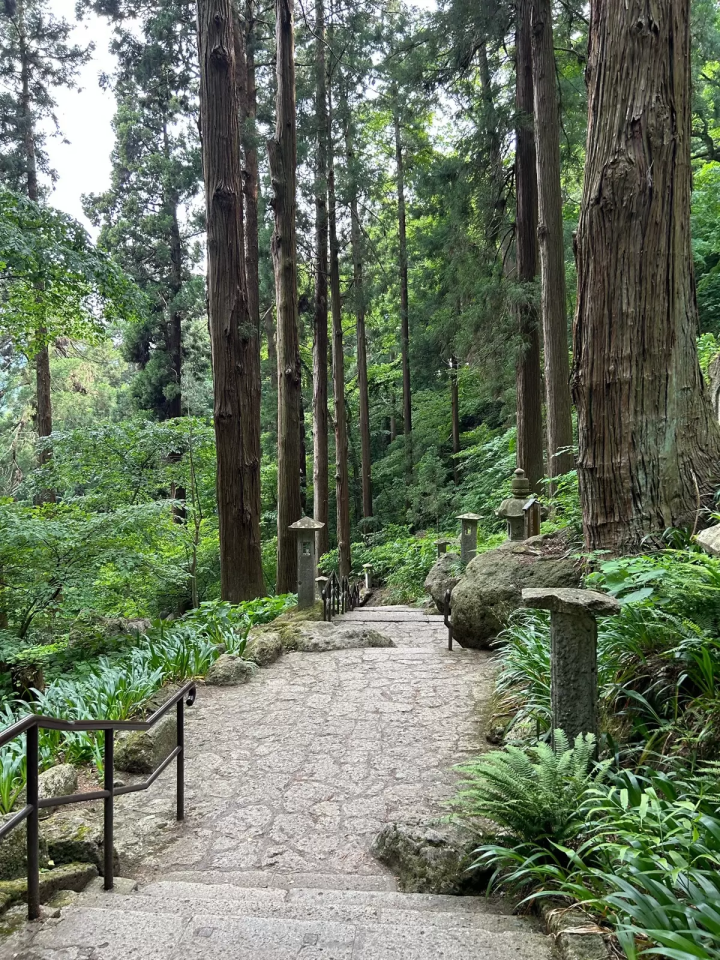
The scenery when descending is also very beautiful.

After getting off the mountain temple, it is delicious food that heals the tiredness. This time, I ate "Cherry Soft" from Fumotoya Main Store.
Standing signboard
At the main sightseeing spots in Yamadera, there are signboards with explanations about the spots. If you read the QR code on the bottom of this signboard with an app called "Uni-Voice", you can read each language (Japanese, English, Simplified Chinese, Traditional Chinese, Korean, Spanish, Portuguese, German, French, Italian) It is a function that translates into Chinese, Thai) and displays and reads out the sentences.
In addition, if you download the app in advance, you can read it offline, so you can use it without a Wi-Fi environment even in places where communication is unstable, such as in the mountains.
For more enjoyment of sightseeing in Yamadera
Tourist guide (Kizahashi-kai)
"It takes about 2 hours and will guide you through the famous historic sites of Yamadera. You might be able to hear interesting secret stories unique to a local guide." Quoted from the Yamadera official pamphlet
Guide fee: 3,000 yen per time (reservation required)
Inquiries: 023-695-2816 (Yamadera Tourism Association)
Yamadera Tourist Guide “Kizahashi Kai”: https://www.yamaderakankou.com/campaign/kizahashi.html
Foreign language guide (Yamaderans)
"Yamaderans is a team of foreign language guides who love Yamadera. We will guide you in English to see the famous 'Fumetsu no Houtou' in the Konpon Chudo Hall of Risshakuji Mountain Temple, and to ' Okunoin' at the top. It is full of local episodes such as history, nature, and beliefs of local people. Let's enjoy Yamadera together! Quoted from Yamadera official pamphlet
Yamaderans Official Website: https://reserva.be/yamaderaguide/about
Sightseeing spots around Risshakuji Temple
Here are some sightseeing spots around Risshakuji Temple.
・Minenoura Ruins
・Makuchi Rock
summary
We introduced Yamadera Temple, one of the famous places in Yamagata City. When I go to Yamadera, I feel that time passes more slowly than usual. I felt tired after the climb, but I felt more refreshed and refreshed. How about visiting Yamadera where you can enjoy nature and history?
Yamagata City is the prefectural capital of Yamagata Prefecture. Surrounded by mountains, the city offers beautiful scenery throughout the four seasons. Famous sightseeing spots include "Zao", which is popular for its frost-covered trees and hot springs, and "Yamadera", a place related to Basho Matsuo. In terms of food culture, dishes that make use of Yamagata's abundant ingredients, such as ``Yamagata imoni'', ``cold ramen'', ``dashi'' and ``ball konjac'', have been passed down. Yamagata City has many images of such nature and history, but in fact, there are plenty of cafes and restaurants, and there are many places where you can relax. On this page, we will post recommended spots and articles to introduce the attractions of Yamagata City, such as popular spots, hidden attractions, and delicious restaurants, in more detail and in an easy-to-understand manner! (Images and videos on this page: Provided by Public Relations Division, General Affairs Department, Yamagata City)
The contents on this page may partially contain automatic translation.


































![[2026] Top 5 Strawberry Picking Spots in Tokushima, Naruto| Farms and Access Guide for January to May](https://resources.matcha-jp.com/resize/720x2000/2025/03/06-227165.webp)

